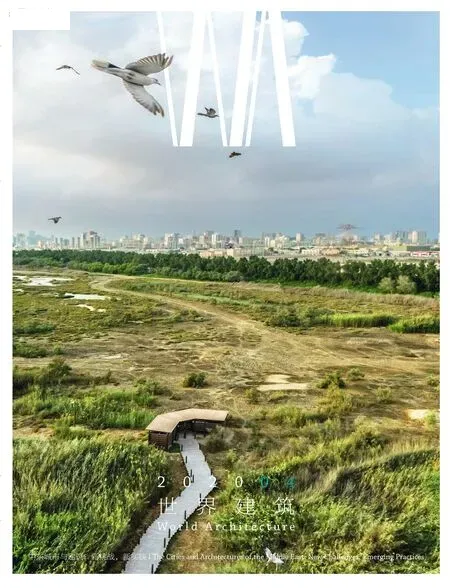桑贾克拉尔清真寺,伊斯坦布尔,土耳其
建筑设计:埃姆雷·阿罗拉特建筑师事务所
这座建筑是应桑贾克拉尔家族之意而设计的。他们希望在俯瞰大切克梅杰湖、有大量封闭社区的街区中建造一座清真寺。主要的问题是与奥斯曼清真寺古典范式的矛盾,那对于今天的施工技术已是空无意义的明日黄花。
由于清真寺并没有既定的形式,而任何洁净之地都可以作为祈祷室,所以项目远离关于形式的讨论,仅仅聚焦于宗教空间的“本质”。身心的愉悦是最重要的。设计的目标是表现光与物质最纯粹的形式,犹如一个质朴的内心世界,而毫无任何文化负担。设计追求的是将建筑隐匿于地段的坡地中,使其植根于大地,仿佛浑然一体,并摆脱一切时间上与文化上的纠葛。
项目位于一处草原景观中,由一条繁忙的街道与周围城郊的封闭社区隔开。清真寺仅有的可见元素是被水平墙包围的庭院和垂直的多棱石体块(光塔),后者表明这是一个特定的“场所”,而铭文表示这是祈祷的地方。随着人在景中游,下山朝着低处庭院的入口走去,顺着天然坡地形成的瀑布仿佛成为踏步。茶室、公共空间和清真寺正对面的图书馆使这个开放空间的集会特征更加丰富。礼拜堂可直接到达,作为一个洞窟状的朴素空间,成为一个效果奇特、令人肃然起敬的与上帝独处的礼拜场所。室内朴实无华,各种材料都是自身真实的表达,毫无赘饰。墙面和天花板强化了净心与谦逊的感受。这里可以定义为一个冥想空间。唯一的装饰是从基卜拉墙上泄出的日光,并在一天中千变万化。这面墙上的缝隙和裂口突出了祈祷空间的朝向性。一个特别的元素是代表无穷的反光黑墙上的词“waw”。这是第一个让女性有机会与男性同排祈祷的清真寺建筑,而不是像所有其他的清真寺那样让女性排到后面。她们被安排在礼拜堂升起并隔开的部位。这个建筑综合体包括了洗礼堂、盥洗室和直通礼拜堂的阿訇室。
这座建筑与地形完全融为一体,并以这种平和的方式再现出大地的造型。下沉的特征和绿色的屋顶为防止热量的得失提供了天然的保温。景观元素主要是无需养护、与周围大草原浑然一体的乡土植物。所有这些特征都避免了额外的能耗和用水。□(尚晋 译)

1 总图/Site plan

2 外景/Exterior view
项目信息/Credits and Data
客户/Client: Sancaklar Foundation
业主/Owner: Republic of Turkey Presidency of Religious Affairs
功能/Function: 宗教建筑/Religious Building
主持建筑师/Chief Architect: Emre Arolat
项目团队/Project Team: Uygar Yüksel, Leyla Kori, Nil Aynalı, Fatih Tezman, Nurdan Gürlesin
总承包商/General Contractor: Sancaklar Foundation
结构工程/Structural Project: Balkar Engineering
随着移动互联技术的不断进步,微信公众平台的功能进一步开放,小程序、API数据接口不断丰富,各种第三方开发平台应运而生。在这不断的技术变革中积极探索,转变教学思维,以大众常用的微信公众平台为切入点,打造轻量、易用的移动端学习平台,改变旧有的教学模式,满足了学生自主学习、个性化学习的需求,更适应了社会与技术发展的趋势,有着广泛的应用前景。
机械工程/Mechanical Project: Setta Engineering
电气工程/Electrical Project: HB teknik
景观设计/Landscape Design: Emre Arolat Architects, Medosa
照明设计/Lighting Design: SLD - Piero Castiglioni
声学/Acoustics: SeyConsulting
结构系统/Structural System: 钢筋混凝土/Reinforced Concrete
面积/Area Information: 地块面积/Parcel Area: 7365m², 总建
筑面积/Gross Area: 1200m², 基底面积/Footprint: 1200m²
项目时间/Project Time: 2011
竣工时间/Completion Time: 2014.01
摄影/Photos: Thomas Mayer
书法/Calligraphy: Mehmed Özçay

3 外景/Exterior view
The building was designed in response to the Sancaklar Family who wanted to build a mosque on a site overlooking the Buyukcekmece Lake, at a neighbourhood of many gated communities.The main issue was a confrontation with the classical Ottoman mosque scheme, which became a blank anachronism with today's construction techniques.
Depending on the fact that a mosque does not have a predefined form and anywhere clean may be a prayer's room, the project focused solely on the"essence" of a religious space, by distancing itself from discussions on form.Physical and emotional pleasure was placed at the forefront.The design aimed at representing purest forms of light and matter, just as a primary inner world, free from all cultural burdens.The disappearance of the building along the slope of the site, anchorage to the ground as if it has always been there, getting rid of all temporal and cultural engagements were aimed.
The project site is located in a prairie landscape that is separated from the surrounding suburban gated communities by a busy street.The only visible elements of the mosque are the courtyard surrounded by horizontal walls and a vertical prismatic mass of stone (minaret), which depicts that this is a "place" and the inscription signifies that this is a place for praying.The cascades following the natural slope turns into steps as one moves through the landscape, down the hill and leads to the entrance at the lower courtyard.The tea house,communal space and the library just across the mosque enriches the gathering feature of this open space.The prayer hall reached directly, a simple cave like space, becomes a dramatic and awe inspiring place to pray and be alone with God.The interior is simple where materials put forward themselves as they are, free from redundancies.The walls and the ceiling strengthen the feeling of purification and humbleness.The space may be defined as a meditation space.The only ornament is the daylight
3 that leaks on the Qiblah wall, changing over the time of a day.The slits and fractures along this wall enhances the directionality of the prayer space.A very special element is the letter"waw" on the reflective black wall of infinity.First time in mosque architecture, women have the chance to pray just in the same row as the men, contrary to being at the back as in all others.They are placed at an elevated and separated part of the hall.The complex includes the ablution halls, restrooms and the imam's house from where he can reach the hall directly.
The building blends in completely with the topography and in this peaceful way,delivers back the form of the ground.This submerging feature and the green roof all above provides a natural insulation against heat loss and gain.Landscape materials are mainly of rural plants that need no maintenance and that merges with the prairie of the surroundings.All these features prevents the use of extra energy and water.□

4 外景/Exterior view

5 平面/Plan

6 剖面/Sections




7-10 外景/Exterior views


11.12 内景/Interior views
评论
青锋:看到密斯·凡·德·罗巴塞罗那德国馆式的几何元素出现在清真寺中,无疑会让我们这些对清真寺并不熟悉的人感到诧异。无论是在大马士革、开罗还是北京牛街,我们所熟悉的是与传统紧密联系的建筑类型,这个建筑显然会极大地改变我们这种习见。回想起来,伊斯兰教对拟像的拒绝,以及清真寺中米哈拉布与朝拜墙的空间化定义,都赋予这种建筑类型先天的抽象性。而抽象性正是19世纪末期以来,建筑界最重要的变化之一。或许,抽象的确是表现超验最为深刻的语汇,光与氛围比符号和象征更为有力。这不仅是一个优秀的宗教建筑,也是对建筑整体表达的出色凝练。
庄子玉:桑贾克拉尔清真寺在是对于传统伊斯兰宗教建筑在原型上的一次超越。建筑师在对于文化符号和文脉特征的抉择中选择了后者。诚如建筑师自述,奥斯曼清真寺古典范式的诸多结论,如高柱、墩柱、拱廊、拱门以及圆顶等形式结果恰属建构文化的范畴;其成因背后是基于特定时代的技术体系与材料应用。当技术的前提被重置,其范式背后的形式,或者一系列被时间赋予的被转译后的语意及符号则不可避免的远离了操作的主体。
于是宗教的本质诉求在场地的氛围中被重提,人与神的沟通开始向更纯粹的物质性靠拢,洞穴感、缝隙感、等一系列跨越更大时间维度的从人类伊始到可预见的未来的回归泛宗教缘起的物质体验被重塑。于是,在代表无穷的反光黑墙前的一个“waw”字前,我们才能回到宇宙洪荒之始,在空旷的石壁间回荡的经文中,去找寻内心的神谕。
Comments
QING Feng: Seeing the reminiscent geometric elements of Mies van der Rohe's Barcelona Pavilion in this mosque undoubtedly astounded us, those who are not familiar with mosques.Whether it is in Damascus,Cairo or Beijing Niujie, we are familiar with the type of architecture closely related to tradition, and this architecture will obviously change our common sense.In retrospect, Islam's rejection of mimesis, and the spatial definition of the Mihrab as well as worship wall in mosques, gave this type of construction an innate abstraction, which is one of the most important transformation in architecture since the end of the 19th century.Perhaps abstraction is indeed the most profound vocabulary of transcendental performance.Light and atmosphere are more powerful than signs and symbols.This is not only an excellent religious building, but also a remarkable extract of the expression of architecture as a whole.(Translated by XU Ziyi)
ZHUANG Ziyu: The Sancaklar Mosque transcends the prototype of traditional Islamic architecture as the architect chooses contextual characteristics over cultural symbols.Just as he says, many elements of the classical Ottoman mosque scheme, such as high columns, piers, arcades, arches, and domes, conform to archi-tectonic culture.Their emergence is attributed to the technological system and material use of certain ages.When the premise of tectonic is reset, the form behind its paradigm, as well as a series of translated semantics and symbols endowed by time, are inevitably distanced from the main subject of manipulation.
Thus, the essential pursuit of religion is reemphasised in the ambience of the site.The communication between Allah and Mantransitions to pure materiality, reconstructingthe feelings of caves,crevices, and a series of material experiences with pan-religious origins.These experiences span long time periods from the beginning of human life till our foreseeable future.Hence, only before the letter"waw" on the reflective black wall of infinity, we can go back to the beginning of time and find the oracle in the chants echoing among the secluded stone walls.(Translated by MU Zhuo'er)


13.14 内景/Interior views

